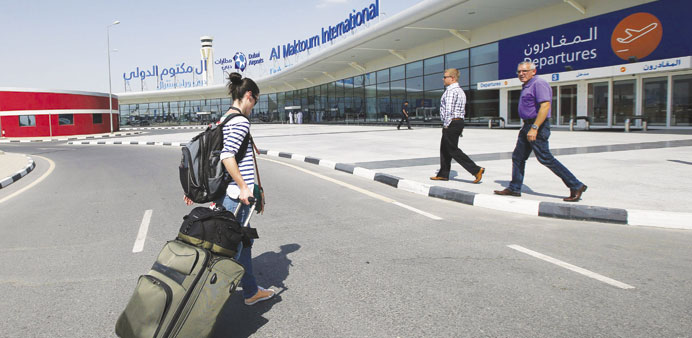A passenger (left) walks on her way into the Dubai World Central - Al Maktoum International Airport in Jebel Ali. Al Maktoum, which opened in October, is targeting a capacity of 228mn passengers at a cost of 156.8bn dirhams ($43bn).
Bloomberg /Dubai
Emirates, the No 1 international airline, won’t be asked to move to Dubai’s new super-hub until 2024, avoiding disruption to its growth as it takes delivery of the world’s biggest fleet of wide-body jets.
Dubai’s Al Maktoum airport, which opened in October and is targeting a capacity of 228mn passengers at a cost of 156.8bn dirhams ($43bn), should instead become an interim base for local low-cost carrier FlyDubai, according to the preferred scenario of a government-sponsored strategy study obtained by Bloomberg News.
The plan would see FlyDubai transfer to Al Maktoum from Dubai International airport next year, before making the switch in reverse in a decade’s time, the document suggests. That would allow Emirates to expand its current base at Dubai International for the maximum possible period, after earlier plans envisaged a move to the new super-hub as early as 2020.
“The preferred transition scenario has the ability to maintain full utilisation of Dubai International while reducing the major build at Al Maktoum for the Emirates hub,” the study says. Construction of a dedicated Emirates terminal at the new airport could be staged, with the building initially housing “spill” from foreign airlines until a “one-go Emirates move” following its completion in 2023-2024.
The masterplan is still under discussion and has yet to be approved, a Dubai Airports spokesman said.
“Such decisions rest with the government,” FlyDubai chief executive officer Ghaith al-Ghaith said in an e-mailed response to questions. An Emirates spokeswoman also said the decision and timing of its hub swap is a matter for the government.
The 62-page study from Dubai Aviation Engineering Projects, a government body tasked with overseeing infrastructure work, suggests the territory’s airports will attract about 103mn passengers by 2020, compared with 66mn last year, rising to 167mn in 2030 and a possible 222mn by 2045.
Dubai International alone would be unable to absorb the projected increase in passengers beyond 2018, the report says.
Unlike most of the world’s fastest-growing hubs, which tap surging economies in emerging markets, Dubai is largely reliant on passengers travelling between other countries as Emirates exploits an advantageous geographical location to establish Dubai as a crossroads for intercontinental travel.
Emirates anticipates that its annual passenger count will reach 70mn by 2020. Founded in 1985, the carrier has a fleet of more than 200 aircraft, 44 of them A380 superjumbos, plus almost 400 jets on order worth $160bn at list prices.
The fledgling Al Maktoum site’s sole passenger terminal currently has capacity for 7mn people, increasing to about 10mn next year to permit the move by FlyDubai and some foreign carriers, and reaching 20mn in 2018 or 2019.
After 2024 FlyDubai will have the option of moving all flights back to Dubai International or keeping some at the Al Maktoum terminal and operating a split-base model.
The first stage of Al Maktoum’s second terminal, for use by Emirates, is slated to open in 2019 with a capacity of 10mn passengers. Foreign carriers will initially occupy the site before being required to move to Dubai International after 2024, though some could switch to the FlyDubai terminal at Al Maktoum if the discount carrier opts to exit completely.
Al Maktoum’s overall passenger capacity will reach 31mn in 2018, by which time spending will have reached 31.2bn dirhams, including 5.5bn dirhams earmarked for expanding Dubai International to its final capacity.
By 2025, Al Maktoum’s capacity will have jumped to 133mn in time for the Emirates move, with a spend of 94.6bn dirhams. Further enhancements will lift the total to 152mn passengers by 2029 and 228mn by 2034.

